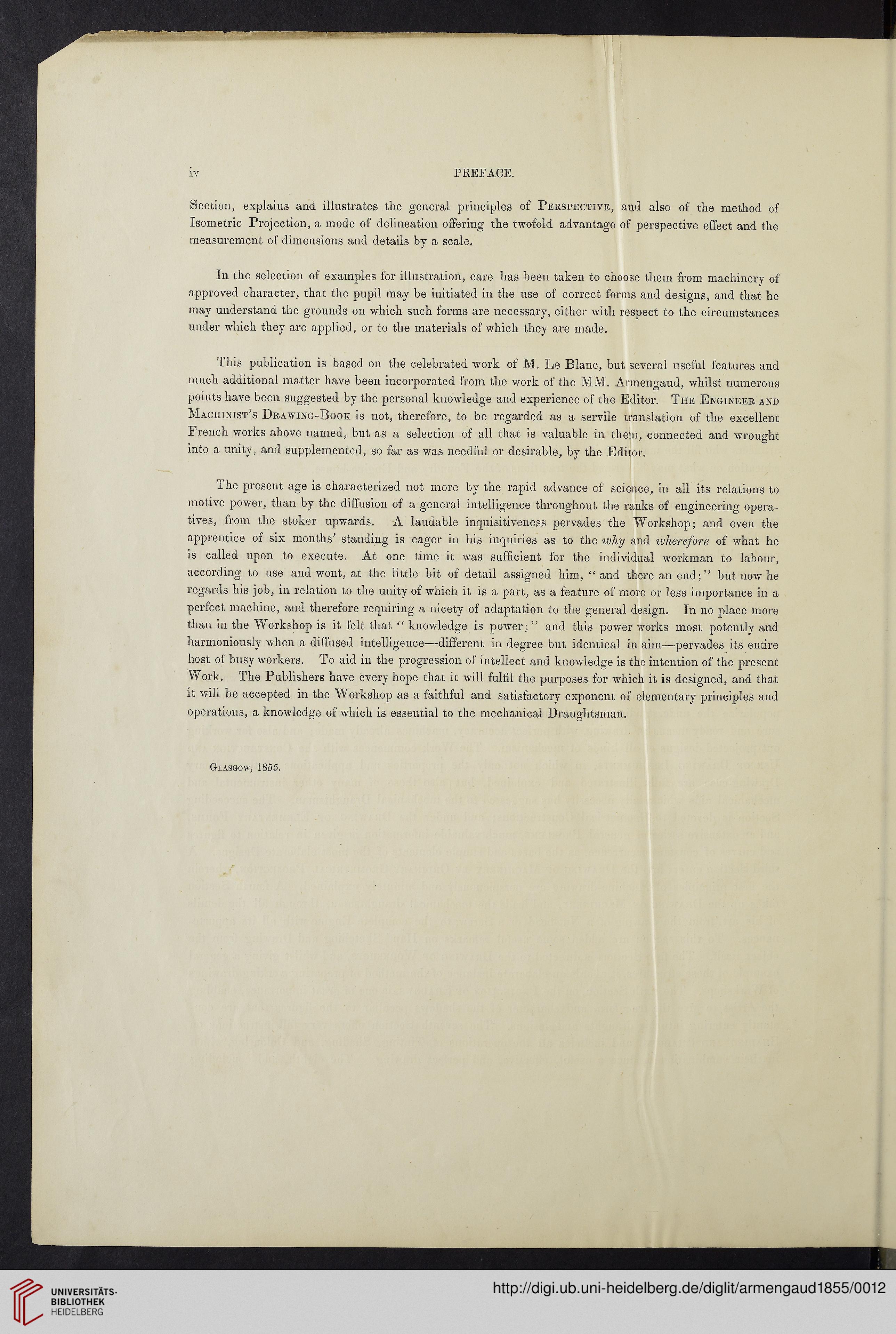1Y
PREFACE.
Section, explains and illustrates the general principles of Perspective, and also of the method of
Isometric Projection, a mode of delineation offering the twofold advantage of perspective effect and the
measurement of dimensions and details by a scale.
In the selection of examples for illustration, care has been taken to choose them from machinery of
approved character, that the pupil may be initiated in the use of correct forms and designs, and that he
may understand the grounds on which such forms are necessary, either with respect to the circumstances
under which they are applied, or to the materials of which they are made.
This publication is based on the celebrated work of M. Le Blanc, but several useful features and
much additional matter have been incorporated from the work of the MM. Armengaud, whilst numerous
points have been suggested by the personal knowledge and experience of the Editor. The Engineer and
Machinist’s Drawing-Book is not, therefore, to be regarded as a servile translation of the excellent
French works above named, but as a selection of all that is valuable in them, connected and wrought
into a unity, and supplemented, so far as was needful or desirable, by the Editor.
The present age is characterized not more by the rapid advance of science, in all its relations to
motive power, than by the diffusion of a general intelligence throughout the ranks of engineering opera-
tives, from the stoker upwards. A laudable inquisitiveness pervades the Workshop; and even the
apprentice of six months’ standing is eager in his inquiries as to the why and wherefore of what he
is called upon to execute. At one time it was sufficient for the individual workman to labour,
according to use and wont, at the little bit of detail assigned him, “ and there an end; ’’ but now he
regards his job, in relation to the unity of which it is a part, as a feature of more or less importance in a
perfect machine, and therefore requiring a nicety of adaptation to the general design. In no place more
than in the Workshop is it felt that “ knowledge is power;’’ and this power works most potently and
harmoniously when a diffused intelligence—different in degree but identical in aim—pervades its entire
host of busy workers. To aid in the progression of intellect and knowledge is the intention of the present
Work. The Publishers have every hope that it will fulfil the purposes for which it is designed, and that
it will be accepted in the Workshop as a faithful and satisfactory exponent of elementary principles and
operations, a knowledge of which is essential to the mechanical Draughtsman.
Glasgow, 1855.
PREFACE.
Section, explains and illustrates the general principles of Perspective, and also of the method of
Isometric Projection, a mode of delineation offering the twofold advantage of perspective effect and the
measurement of dimensions and details by a scale.
In the selection of examples for illustration, care has been taken to choose them from machinery of
approved character, that the pupil may be initiated in the use of correct forms and designs, and that he
may understand the grounds on which such forms are necessary, either with respect to the circumstances
under which they are applied, or to the materials of which they are made.
This publication is based on the celebrated work of M. Le Blanc, but several useful features and
much additional matter have been incorporated from the work of the MM. Armengaud, whilst numerous
points have been suggested by the personal knowledge and experience of the Editor. The Engineer and
Machinist’s Drawing-Book is not, therefore, to be regarded as a servile translation of the excellent
French works above named, but as a selection of all that is valuable in them, connected and wrought
into a unity, and supplemented, so far as was needful or desirable, by the Editor.
The present age is characterized not more by the rapid advance of science, in all its relations to
motive power, than by the diffusion of a general intelligence throughout the ranks of engineering opera-
tives, from the stoker upwards. A laudable inquisitiveness pervades the Workshop; and even the
apprentice of six months’ standing is eager in his inquiries as to the why and wherefore of what he
is called upon to execute. At one time it was sufficient for the individual workman to labour,
according to use and wont, at the little bit of detail assigned him, “ and there an end; ’’ but now he
regards his job, in relation to the unity of which it is a part, as a feature of more or less importance in a
perfect machine, and therefore requiring a nicety of adaptation to the general design. In no place more
than in the Workshop is it felt that “ knowledge is power;’’ and this power works most potently and
harmoniously when a diffused intelligence—different in degree but identical in aim—pervades its entire
host of busy workers. To aid in the progression of intellect and knowledge is the intention of the present
Work. The Publishers have every hope that it will fulfil the purposes for which it is designed, and that
it will be accepted in the Workshop as a faithful and satisfactory exponent of elementary principles and
operations, a knowledge of which is essential to the mechanical Draughtsman.
Glasgow, 1855.





